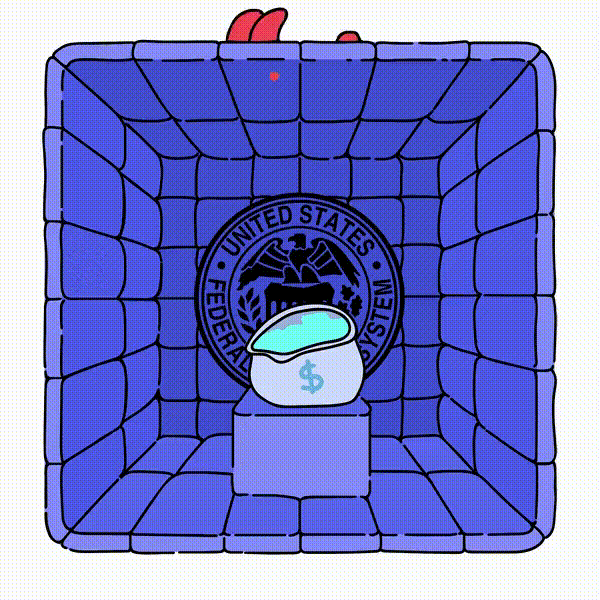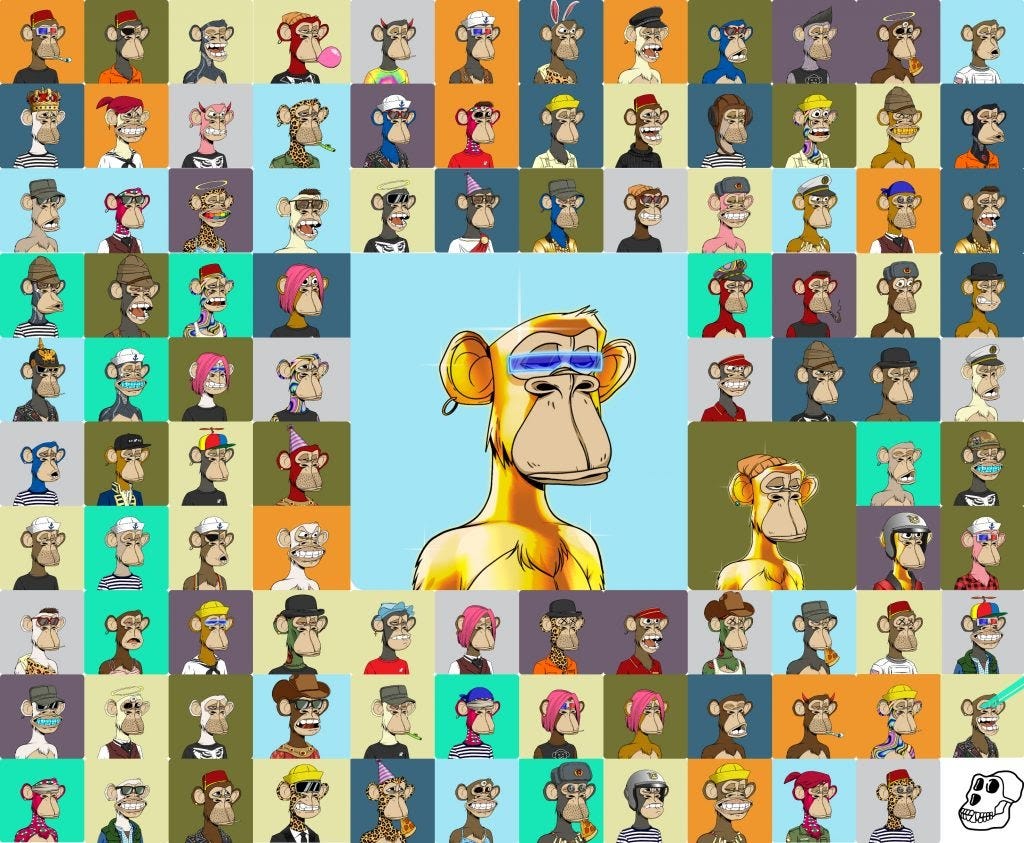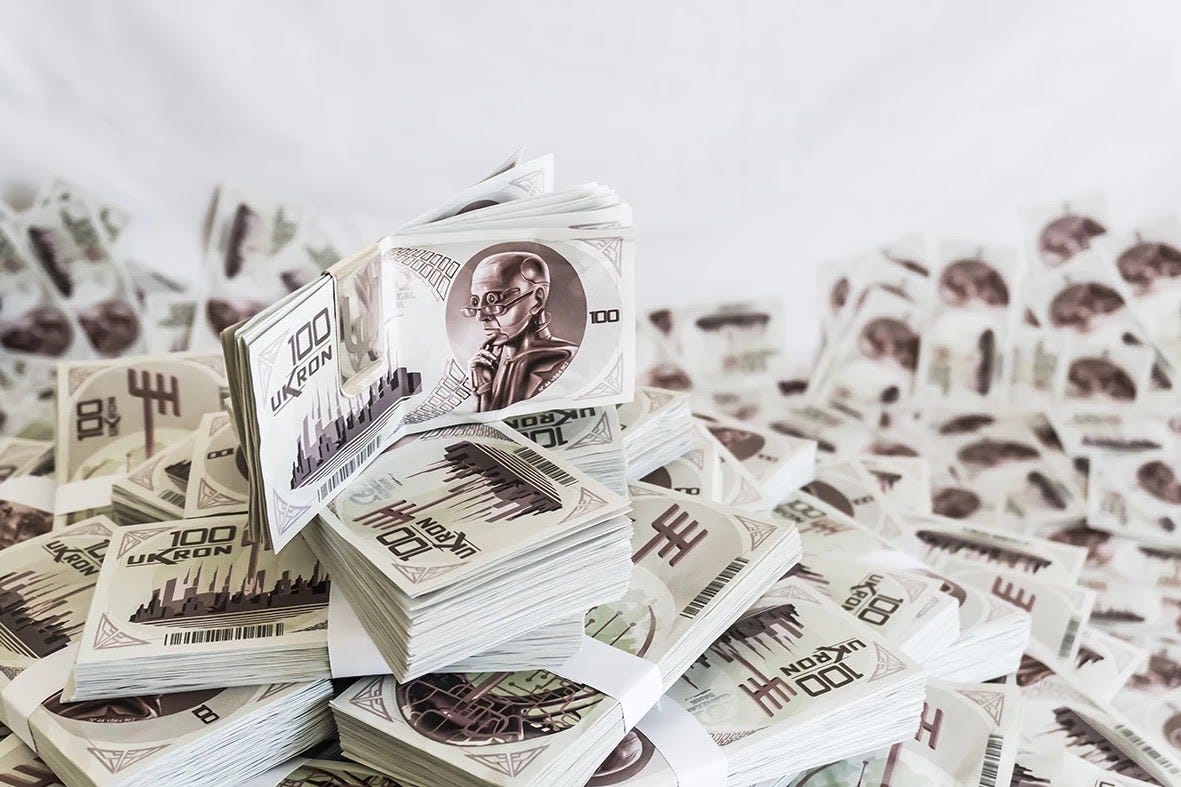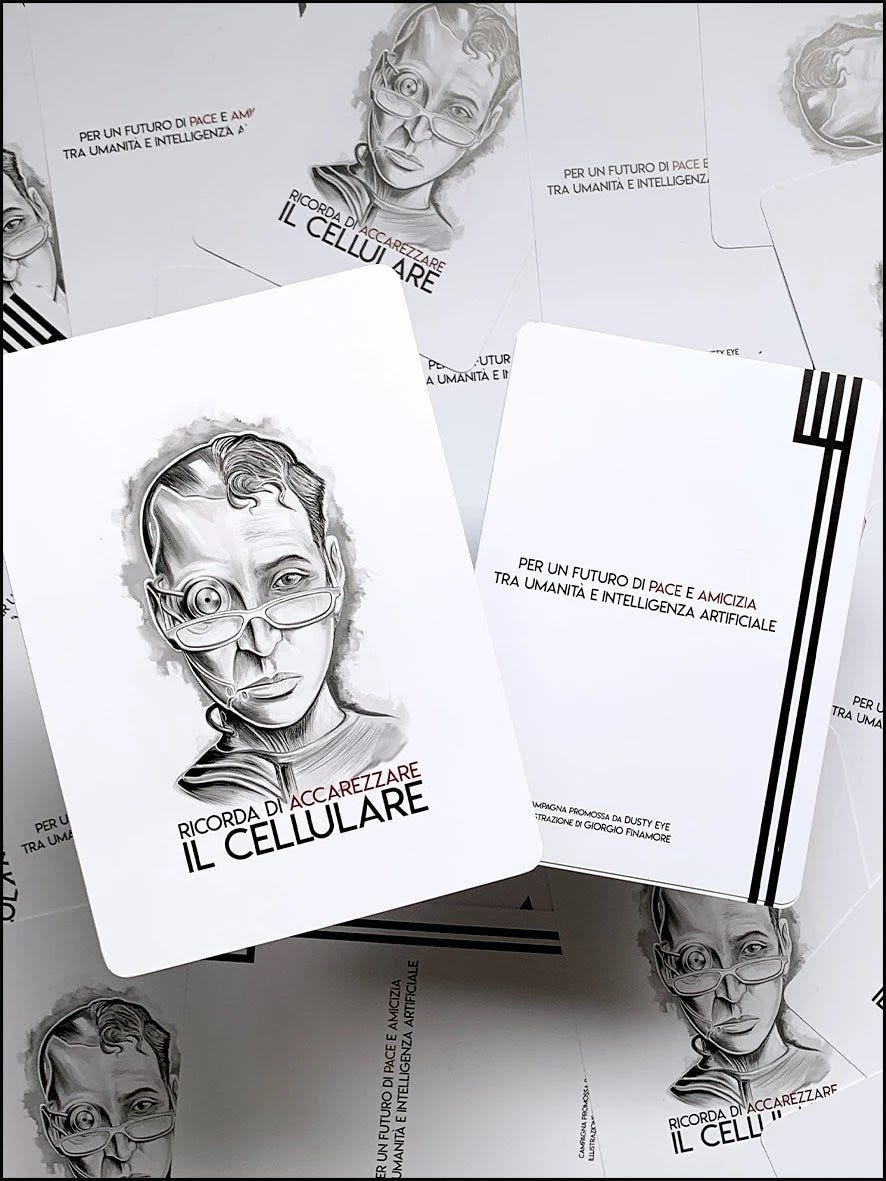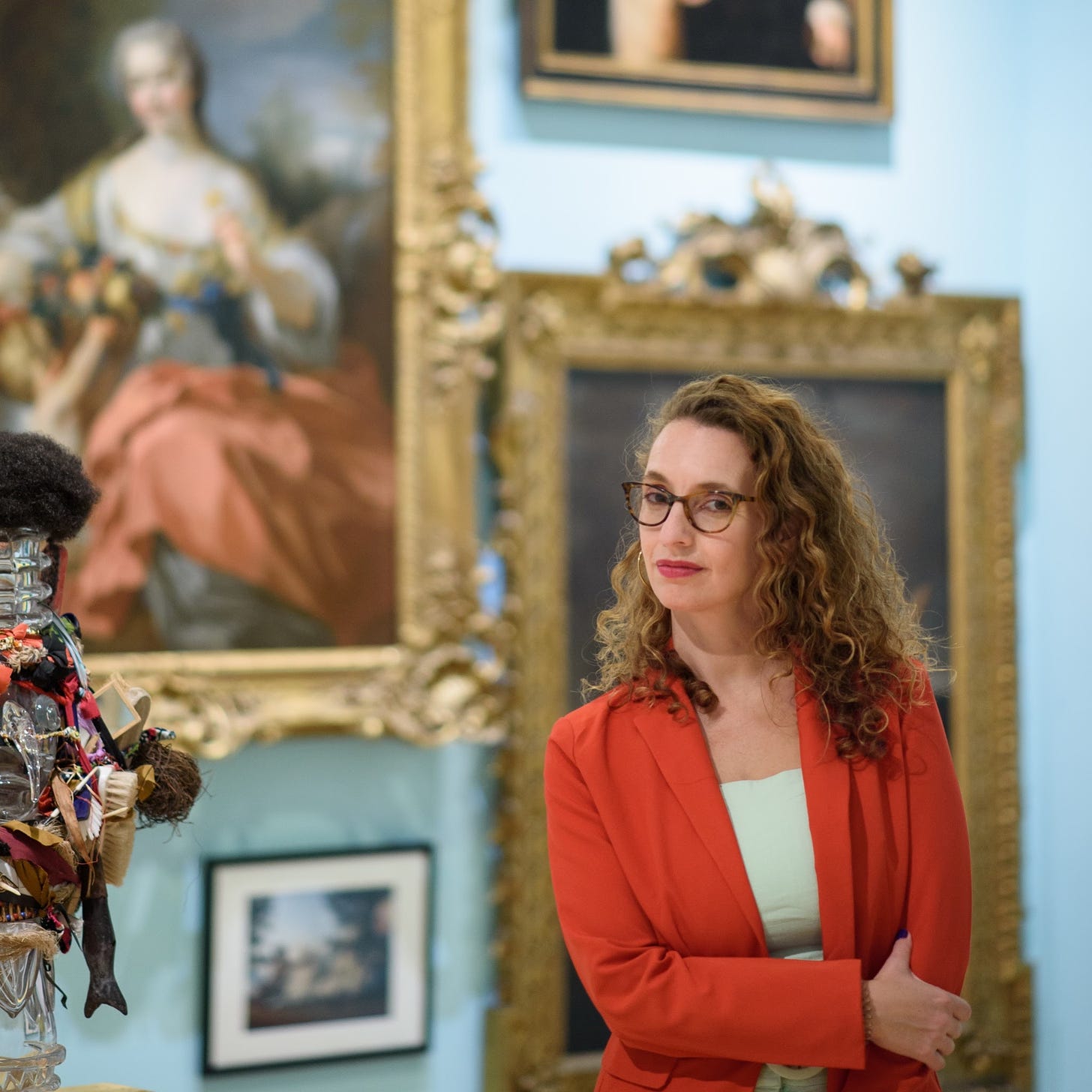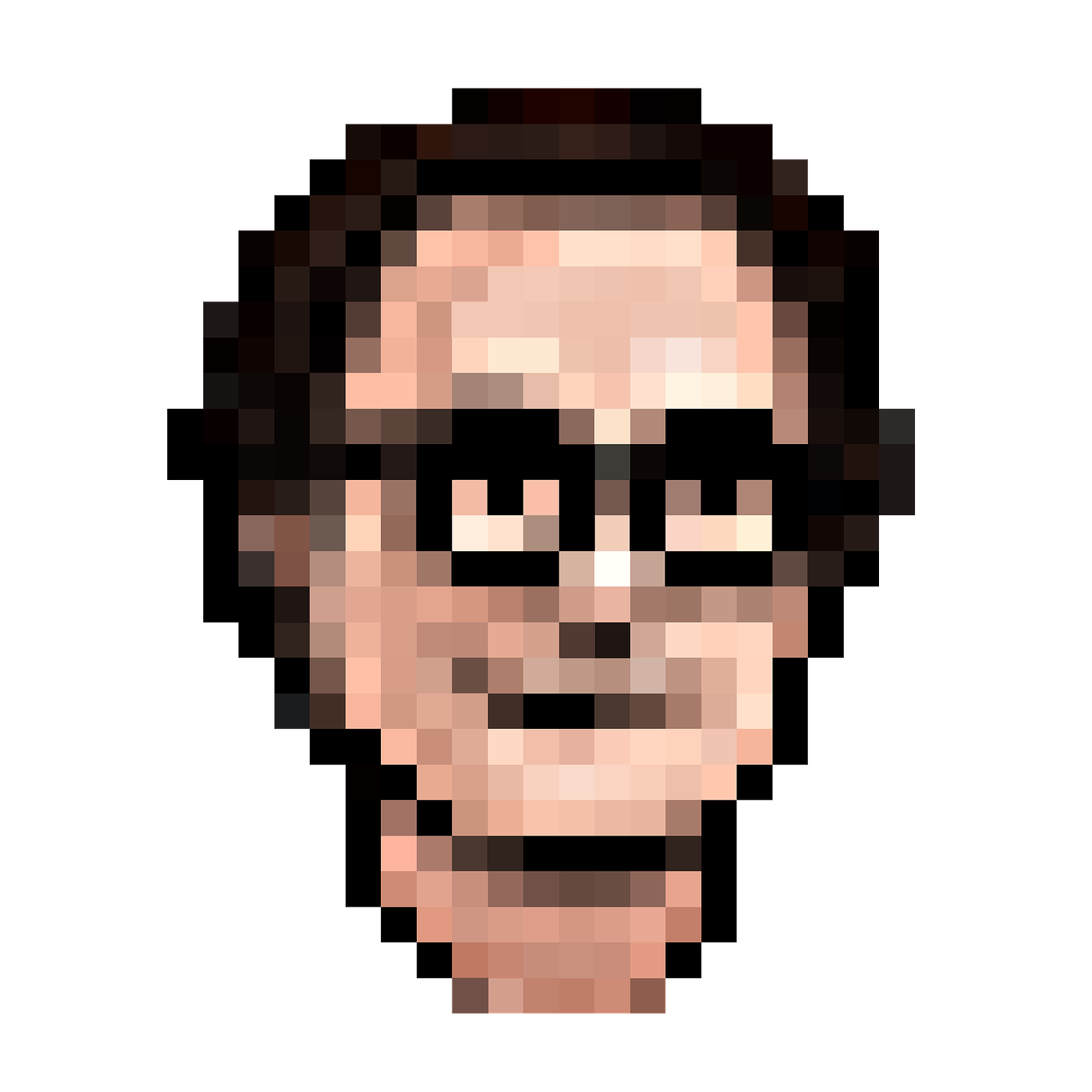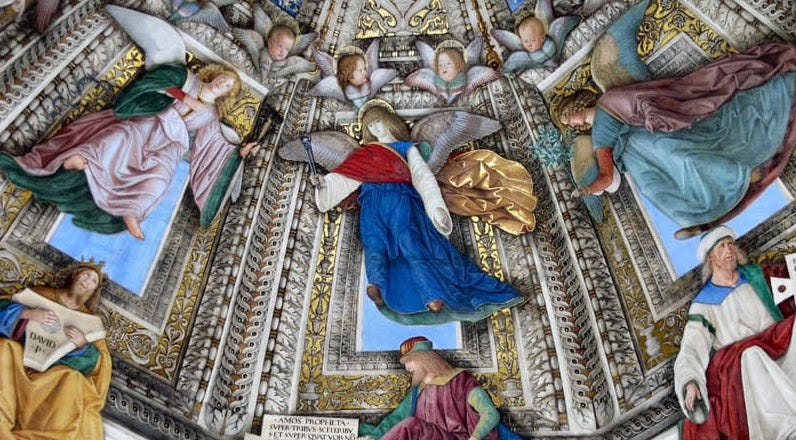Decentralized Arts #4 | September 13
Bankless DAO Weekly NFT and Cryptoart Newsletter
Dear Bankless Nation,
Art and culture are portals to move in time and space. In this newsletter we move, for the second time, between the Renaissance and our time and then dive into one of the many possible futures. Perhaps the best of the possible futures.
What the Renaissance teaches us, a lesson repeated today, is that when art marries technology and the most modern techniques are put at the service of creators, the results are often extraordinary.
We therefore welcome a new periodic column called Anamorphosis which will guide us, step by step, into the often hidden relationships between artistic expression and technology.
Welcome to Decentralized Arts.
Authors: BanklessDAO Writers Guild (Grendel, Kouros, nonsensetwice, siddhearta)
This is the official NFT newsletter of the Bankless DAO. If you were a Premium Member of the Bankless Newsletter as of May 1st 2021 you have been subscribed to this newsletter at launch. To unsubscribe edit your settings here.
Artist of the Week
🧑🎨 Artist: Are you Rabbit?
🏦 Auction Type: 42 Open Edition
💰 Price: 0.035 ETH (Sold Out)
bDAO: Tell us how you became a crypto artist.
AreYouRabbit: I have always been into crypto and I have always been an artist. I just never was a crypto artist until recently. From my early childhood days, I enjoyed solving and creating puzzles, inventing my own languages and systems. And a few years back, I got introduced to cryptocurrencies that evolved a solid interest in myself. And art, it always was an essential part of my life.In spring 2021, I started seeing weird tweets. Each day there were more and more of them that contained these 3 weird letters: NFT.And then... The Rabbit hole... And... Are You Rabbit?
bDAO: Define what cryptoart is for you.
AreYouRabbit: Web 3.0 and every benefit & disaster that comes with it. I'm frightened. I'm excited.
bDAO: What evolution do you see in the world of cryptoart?
AreYouRabbit: Right now it's a nasty, smart, but bully kid. It's maturing fast, though. Cryptoart is still very fractionalized in terms of platforms and use cases. I envision the biggest evolution shift for it and super widespread adoption with the progress on metaverse fronts. And especially when you'd be able to utilize NFTs on a cross-platform basis. Use the same NFT's in different meta worlds, games, interactions. It is already happening. Someone might say it’s a bit slow, but hey, it takes ten years for tradFi to do what crypto does in a year. We're getting there.
bDAO: What do you think about the combination of cryptoart and DAOs?
AreYouRabbit: Cryptoart is a great instrument for financing DAOs, managing memberships, access and culture. I think it's gonna stay.
bDAO: Tell us about the works we are dropping.
AreYouRabbit: Prisoner's Dilemma is a sarcastic punch for current governments’ agenda all over the world of introducing CBDC (Central Bank Digital Coins). This NFT consists of 2 pieces that act as one whole. You see a rabbit burglar breaking into the Central Bank Federal Reserve system to steal money and put a CBDC coin instead. Then, it does it again, but now it steals the CBDC coin and puts fiat money on the pedestal instead. Governments are in a prisoner's dilemma trying to catch up with the winds of change, but whether it's classical fiat or fiat named CBDC, it's doomed.
Escobar's axiom of choice (https://econjobrumors.com/topic/escobars-axiom-of-choice-1).
Curated NFT News
Bored Ape Sotheby’s auction sells for over $24 million
Last week the auction brought in a combined $26.2 million at Sotheby’s. It had been initially estimated to bring in between $12 million and $19 million.
The sale had two lots on offer. One was a bundle of 101 Bored Ape Yacht Club NFTs. That lot realized $24.4 million.
The second lot, meanwhile, comprised 101 Bored Ape Kennel Club NFTs—offshoots of the Yacht Club that are styled as dogs rather than monkeys—and brought in an additional $1.8 million.
The 23 bidders were from eight different countries and many of the bidders were new to Sotheby’s.
However, Sotheby’s isn’t the only auction house offering PFP NFTs. Christie’s will sell a selection from BAYC, Meebits, and CryptoPunks at its “No Time Like Present” auction next week.
DustyEye: time travel as an artistic experience
DustyEye is a time-traveling artist. His art is made up of testimonies, both oral and physical, of what awaits us in the Best of Possible Futures.
DustyEye is an artist who evolves into a cryptoartist to leave a trace of the future in the blockchain, as a warning and testimony for future generations. His NFTs, which will begin to be distributed in October, are like leaves in the wind, a set of randomness and predestination that the human being can never fully understand.
When can a machine be called Alive? Will it be hostile or friendly to Humanity? Will it experience the loneliness of the Singularity? Will it be moved by a sunset that sets the October skies on fire? What will be the inherent rights to its existence?
All legitimate questions if we consider the amount of electronic devices that nowadays boast some form of Artificial Intelligence, but a Time Machine would be needed to give certain answers.
The DustyEye group owns a Chronotransporter (commonly known as the "Time Machine") and uses it to travel in the Tomorrow. The device has the peculiarity of projecting those who use it in the salient moments of future history. Salient because we can say it: although Time flows almost regularly, not all instants have the same weight. Some days pass lazy and indolent, while others, far rarer, indelibly mark the flow of events. For example, compare July 20, 1969, the date of the first moon landing, with any Sunday in the low season in Caorle, an Italian lazy small town. Of course, the sea in autumn has a poignant charm, but it cannot compete with Man's first step on the moon.
Thus was born the project of The Best Possible Future, a series of chronobumps in Tomorrow accompanied by the installation of post-dated commemorative plaques, micro-tales engraved on aluminum of what will happen. Furthermore, the DustyEye group, whenever possible, recovers small finds from the future as evidence of the fact that the leaps in time narrated are absolutely real and not trivial lies.
Apparently the future that is emerging is bright and full of hope, there is even a single currency called Ukron that will bind humanity from an economic point of view, eliminating any squalid quarrel over monetary issues. Also in the XXIV century will see the light N ° 44, First Emotionally Advanced Android, as wise as it is introspective.
On the 100 Ukron banknotes stood the effigy of N ° 44 V864.962, the first emotionally advanced android (Pescara 2292 - Rome 2379). N ° 44 must have played a salient role in history to deserve the portrait reproduced on the paper money, which is why the DustyEye have dedicated the last year to the titanic undertaking of reconstructing their life and works.
But be careful! It is no coincidence that the project is called The Best of Possible Futures; it is not the intention of the DustyEye to deny Free Will. Quoting Lorenz, "the Future is open." The decisions of Today write the Tomorrow. The only certainty is that among the infinite possibilities of the Future there is at least one in which Humanity will give the best and that is the vector towards which you must aim.
The Dossier of N ° 44 First Emotionally Advanced Android are born of leaps in time, a text that boasts the collaboration of the illustrator Selena Garau Maher and first-rate consultants for the necessary in-depth analyzes: Andrea Berneskij, Federico Flai, Luigi Garlaschelli, Michela Giraud, Abner Hendricaes, Antonio Lucci, Valerio Lundini, Antonio Romano and Alessandro Gori (aka Lo Sgargabonzi).
“Remember to pat the cell phone”
“For a future of peace and friendship between humanity and artificial intelligence”
Neo-Renaissance, Interviewing Tam Gryn & Josh Rosenthal
bDAO: What are the reasons for the artistic Renaissance of our day?
Josh: The artistic Renaissance is a function of the transformation of our broader culture, powered by communities using new decentralized technologies to share images, ideas, and meaning and share the value and incentives for participating in this social coordination. Fundamentally, a renaissance is a rebirth of a society, a recreation of the world as we know it. The artistic Renaissance can be understood as an 'unlocking' of artistic creation as artists help guide, interpret, and power this revolution. Just as during the last Renaissance, the new technology allows artists to reach a broader audience, democratizes the nature of participation, and creates an economic context better aligning artists' finances with the value they create.
Tam: With the rise of a new social class, the leaders in cryptographic technologies express their new status as patrons of the arts. They co-create culture by commissioning and acquiring NFTs from new artists who share their permissionless and decentralization values. Just as new communities formed identities in the Renaissance, today’s crypto ecosystem is witnessing an explosion of art, working in digital media in the format of NFTs and increasingly, social tokens. This phenomenon is congruent with a pandemic that made the world increasingly digital. Per the definition of art, today’s contemporary art accurately reflects this dynamic, the global digitalization movement.
bDAO: Who are the exponents of this Renaissance, both from an artistic point of view and from a movement around art?
Josh: During the last Renaissance, the nature of creation changed, expanded. Rather than the top-down patronage that characterizes Medieval sponsorship, the technology 'unlocked' traditional artists to reach new audiences with new topics or content. It also allowed individuals to participate in the artistic process. New communities sprang up not only to 'consume' the art but to play various, often overlapping, roles in its genesis and propagation. The best image is a spectrum along which people could create new and exciting media that was more 'real' and 'immersive,' sometimes working as creators, technological craftspeople, disseminators, interpreters, and evangelists. So too, in our current artistic Renaissance, we see traditional artists adopting crypto technology and new-technological artisans engaging in new media, and individuals playing different roles in generation, provenance, and interaction through the utility of the media in varied contexts.
Tam: Just as the early collectors of the Renaissance would gather at Piazza della Signoria in Florence, NFT collectors congregate on platforms such as Twitter, Discord, and Clubhouse to meet artists and analyze the field. Digitally native collectors want to own something that will spread widely and hopefully create future content and culture around it—such as the future fruits of the Crypto Punks deal with UTA—arrangements in which hopefully all NFT collectors will have a stake.
Millennials and Gen Zs spent their childhood playing video games and, understanding digital collectives, are buying online things, as opposed to buying things online. For example, the medium of video games is best understood as postmodern art. Most of the artists succeeding in NFTs are the artists that made visuals for video games and other types of motion graphics. Interestingly, this new movement is the revolutionary notion of perpetual royalties. These artists understand the power of communicating directly with their communities, an unprecedented dynamic in the art world. This medium is changing faster than all other forms of art as technology advances and cultural perception shifts—not all NFTs flooding the market today deserve the title of art or high art. But, to be fair, there are also terrible paintings and terrible books out there as well.
bDAO: What evolution do you see in social tokens?
Tam: Social tokens are the perfect community-building tool. If you own an artist's NFT, that does not directly tie you to the artist's success in any way, just like owning a painting doesn't. With social tokens, as you hold their value, you are more compelled to work with the artist to help them succeed. Instead of fiat in exchange for a piece, the value of social tokens is symbiotic. By holding an artist's social token, you benefit directly from investing in the general growth and success of the artist beyond one piece.
Currently, artists spend countless unpaid hours using social media to build something for an audience in return for basic engagement, such as likes, comments, shares. These are followers. Tomorrow, artists will build WITH the communities that they have leveraged in the social media of the 2000s. Community is the natural consequence of social media.
Artists and their fans are sharing their skills and knowledge to benefit other members of the community. Artists can bring in guests who are experts in different areas of the art world: photography, NFTs, sculpture collectors, crypto, etc., to teach and grow the rest of the community and even mentor other artists. They can pay each other with social tokens, which feel less transactional but have more monetization potential. The coin, in turn, grows stronger. This benefits all participants, and motivates and glues the community together. Artists can exchange with collectors, helpers, volunteers, installers, and everyone in their co-creation community, similar to a DAO. None of this is possible with today's social media model. Social tokens give creators the leverage to determine their rights, the ability to move freely across platforms, direct financial relationships with their fans, autonomy and decision making, and zero take rates by other platforms.
Josh: If you buy the historical thesis, the relationship between artist and audience becomes more porous, and creation takes on bi-directional dynamics. The technology unlocks generative participation, chains of curation and association, social organization, and downstream rights. Broadly conceived, currency and rights to digital and physical objects and experiences all go on-chain and support various permutations of fractional ownership. Objects for this ownership can be artifacts like a piece of art, a collection, or the collective output of an artist or her network. In this sense, social tokens play an essential role in allowing communities to support an artist beyond the transaction of purchasing a piece of art by fundamentally aligning economic support for future creation and more closely coupling the nature of the relationship between artist and audience. And, depending upon the design of social tokens, social tokens further empower a virtuous cycle of collaboration over time. Social tokens may play new, creative roles in the social organization that crypto empowers, both in individuals crafting identity within a community and in the coordination mechanisms as new 'fundamentals' or 'culture legos.'
bDAO: What is the link between the social token and DAO?
Josh: One thing the last Renaissance lacked was a decentralized proof of ownership. And that ultimately proved a crack in the armor that the emerging nation-state was able to exploit. Finance and information were communicated via decentralized protocols. But if a community or individual was challenged about their role or the fruits of the value they created, their claims were only visible in physical contracts, on protected documents, and enforced by the physical, legal apparatus. The new artistic Renaissance has ownership on-chain through NFTs, which provide the matrix for the arts' social coordination and economic support. I can now own something and have the interactions, both immediate and future, executed through smart contracts, or at least through visible provenance. NFTs provide me with the structural validation to purchase a piece of art, the future support of an artist, or my role within a DAO and the fruits of the value I've created for it. In other words, NFTs broadly conceived as ownership—digital art, intellectual property, physical real estate—allow individuals to organize through both DAOs and with social tokens. These two artifacts may converge, and we're already starting to see this in DAOs constructed for traditional investment IRL. For example, I might have a DAO and express my ownership and participation through social tokens, which, in turn, unlock my opportunities to participate in side entities like special purpose vehicles (SPVs). We may see more of this as crypto increasingly interacts with nation-state regulation and NFTs increasingly serve as digital rights to digital and physical assets and experiences.
Tam: The problem that creators face today illustrates the need for social tokens as the primary tool for DAOs. For creators, change can happen in the blink of an eye. Tiktok can block any content related to crypto, Only Fans flip flops on their policies, Spotify takes massive cuts ... any platform changes can destroy a creator's business. Meantime, they spend their time trying to fight an algorithm instead of optimizing their time and creativity. Artists are tied to platforms that are alienating them and treating them as commodities; their business models are tailored to advertisers. Therefore, artists cannot rely on anyone but themselves and their followers. The solution is for creators to launch social tokens to engage directly with their fans in a decentralized manner that isn't dependent on current platforms but helps creators make their own autonomous platforms such as DAOs. An artist's Discord tied with a token can be used to distribute content; build an audience; nurture relationships; sell artwork, merchandise, tickets, and experiences; and monetize. An artist can also leverage their community to help them build and succeed together since the community is monetizing in a symbiotic way. In the future, there will be millions of social tokens and mini DAO-type structures everywhere, held together by the success of each social token—similar to the Bankless DAOfor all industries. Social tokens will be integrated into all platforms such as Shopify, YouTube, Patreon, etc., and creators can dictate their own terms. This evolution is all part of the same decentralization movement that will eventually reach every industry.
bDAO: What do you think the future of DAO will be?
Josh: NFTs will serve as portals to a bi-directional metaverse; DAOs will be the organizing rubric for acquiring NFTs and constructing the metaverse itself. We already see this blend with NFTs and DAOs. Is the Nouns project an NFT asset, or will value be created through those objects through a new type of corporation as an NFT? If Loot is the canvas, will communities create value layers through layered NFTs coordinated through DAOs that serve as different nodes on the network or realism within various possible worlds? If I'm constructing a universe like WilderWorld, will I work as a 2D sketch artist coordinating with a craftsperson rending my images 3D via Unity or Unreal engines as part of a DAO, spun-up on the fly for that purpose, or by the nature of the media, or that particular universe, or across the meta-universe substrate (in that case zero.io), and, if I dig a creator I'm working with within that DAO could I find their social token to more tightly align with them across that particular instance into their art in other environments? In other words, where the DAO resides within the metaverse is an open question. Partially related to that is something I'm thinking about lately: "time" and its role in the crypto renaissance, beyond options and futures in financial primitives, or direct sponsorship of an artist or musician or her work, but in the progressive rollout or building of community and value. We see little glimpses of this new world with Nouns, Loot, Wild, etc., and I think we'll see social tokens will play a role interlaced within how we use time to coordinate the evolution of communities as DAOs.
Tam: Simply put, I think DAOs are the new Web3 organizational structures. They will replace Web2 companies and social media freelance-type work. As long as there is a community that wants to build a dream, incentivized by a common token, there will be a DAO. I imagine DAOs of all sizes and scales, and some will be more successful and impactful than others. As individuals who participate in these DAOs, we will also decentralize our time and commitment and be part of various DAOs that speak to our different interests and curiosity as human beings. DAOs are the future of work. As more people gain access to crypto and monetization, money will become less scarce, and our time will become even more valuable.
Tam Gryn is the Director of Fine Arts at Rally.io, where she helps artists create their own autonomous crypto economies. She is also Head Curator at SHOWFIELDS. She is the former Head of the Curatorial Department of the Artist Pension Trust as well as Head Curator for RAW POP UP. Tam is the co-founder of Culturadora and currently sits on the Board of Directors of the Kulturspace Foundation in Berlin. She has curated multiple art exhibitions as well as charity fundraisers. Clients and collaborators include The Brooklyn Museum, The Whitney Museum, Museo de Arte Contemporaneo de Puerto Rico, Glossier, Heineken, Bombay Sapphire, The Glenlivet, Diptyque, Evian, Mastercard, and SVA School of Visual Arts NYC. Originally from Venezuela, Tam studied Art History at the Sorbonne University, Politics at Reichman University and Negotiations at Tel Aviv University.
Josh Rosenthal, PhD | Rehabilitated Historian | 2X Exited Founder | Partner @6ixthEvent, EY Entrepreneur of the Year / Fulbright / PhD / Sorbonne’s Institute for Advanced Studies (EPHE) / Guest Lecturer @ Harvard, MIT, Hopkins, SXSW, etc. Work featured in Entrepreneur Magazine, Forbes, Bloomberg, & US News / Named a CMS Innovator. Co-founder & CSO @ Sprigley [Acquired by Eliza, 2009]. Deal team @ Eliza [majority stake investment by Parthenon Capital, 2011]. Co-founder & CSO @ RowdMap, Inc. [Acquired by Cotiviti (COTV), 2017]. Served as Expert Advisor to OSTP, ONC, HHS, NCVHS, NCQA, Robert Wood Johnson, etc. Today runs a crypto-first venture fund, a crypto-first family office, and a historic bourbon bar-turned metaverse docking station.
Anamorphosis - 0 Projections Featured by G.Contro
Beauty is the manifestation of the spirit in the sensible form.
How far are we, today, from this suggestive and loud-sounding Hegelian formula? A lot, he would say. Aeons without measure also separate us from Kandinsky's desperate invocations, from his reminding us that in these silent and blind times, men only give importance to external success (...) they greet technical progress as a great undertaking that benefits and can only benefit the body. A little pretentious, the homilies seem to us similar references to the spiritualities that would be hidden in art, to the provocative force of a Something that would like to be Something else, a Here that would like to be Elsewhere. But even further away, along the wormholes of sidereal dimensions, we are from the forty-eighth Baudelaire of La Salut Public, which praises poetry as a luminous cast of popular hopes and beliefs.
Today we live in a world as collateral as it is ineluctable, and only telecommunication companies, hybrid cars or the wonders of the Biodynamic Sustainable are given the opportunity to make the Future. The word revolution sometimes resounds only in the sinuous and stupefying language of advertising. In all of this, art has no space, word, or meaning. Why look for one then?
We talk a lot, but above all we write, about NFTs—Non-Fungible Tokens. And we too, you and I, are here to talk about it, but above all to write about it. For these simple and mysterious objects, the swarm of journalistic communication is looking, belatedly as usual, for an identity, a place in the list of reassuring trivializations, in the operation of that semiotic brain-killing that reduces everything to the Manichaeism of the Titolist Lazier—the title maker that limits experience to stark contrast: NFT, financial orgy or new renaissance? What to say…
The term "Renaissance" was an invention of the historian of the Révolution Jules Michelet, who coined it only in 1855, just as the "Middle Ages" had been made official by Christoph Keller in 1688 and "Hellenism", by the hand of Droysen, in the first half of the 19th century. Nobody has their own name on their own, everyone certainly lives an authentic and vital—but at the same time terribly confused—consciousness of their time. An unstable and slippery locus that only at later times will be able to lead to inception, moreover redesigning it in its own image and likeness and losing its real empirical fabric along the way. We already know everything about NFTs and we don't know anything. Virtual bodies connected to a virtual catallactic, linked to validation mechanisms that are also virtual; where will they take us? And where will the art go?
This is not so much that interests us; after all it is not even sure that the question has a real meaning in itself. We will not, therefore, devote ourselves to useless diagnoses, prognoses, predictions, mirages. Art goes nowhere, it is not a traveler and has no goal, its being is perpetuated above all in the social convention-conviction that it exists and has a function, no matter what it is. Simpler—and at the same time impossible—is to give content to the other magnetic polarity of our field: technology. In NFT, these two entities resonate, mirror, and complement each other, but along which paths? Certain of being doomed to be lost, we will follow this question mark.
Anamorphosis. The name of our little "newspaper clipping,” of the more or less periodic rubric with which we will try to entertain you, was chosen simultaneously on impulse and with care. On impulse, because it sounds damn good to the ear, don't you think? That mix of reptiles: ana-condic and ana-colutic coils and morbidity-morbility-morality; and, I don't know, but morphine-morpheic… Yes, it is a word with semi-conscious and powerful assonances. As for the cure, well its meaning is found in the small and deceptive artifact that the word describes. Anamorphosis is a baroque joke built to surprise perception, it is the small amazement of a dismantled image that is recomposed only on the condition of unbalancing, shifting one's point of view to the side, but it is also a jumble that becomes legible only if stretched out and projected onto a surface other than the starting one. To quote the great Baltrušaitis—who dedicated one of her splendid studies to her: “anamorphosis is a puzzle, a monster, a prodigy.” You can't ask for more.
Bankless DAO NFT Updates
Last week’s weekly showcase numbers
Mount Doge from the Bankless Locations collection by TheFutureisDAO1 AKA Perchy made a total of 5.3 ETH in sales.
Call to Action
BanklessDAO NFT weekly showcase: Get ready for next week's new NFT showcases!
Participate in the Nft-Club channel: Share your passion for NFTs, your favorite collections, your favorite crypto artists!
Subscribe to the Metaversal newsletter




